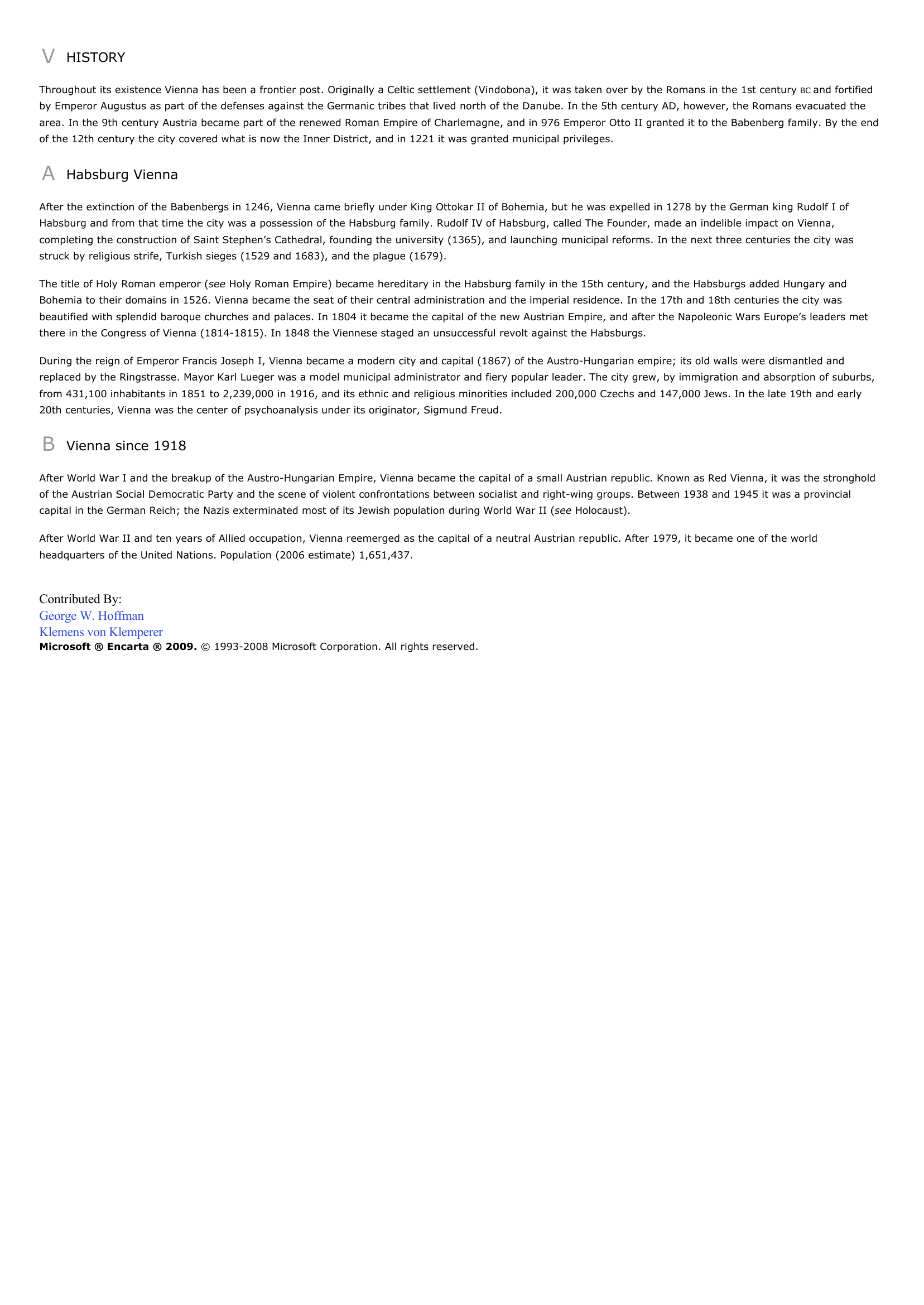Vienna - geography.
Publié le 04/05/2013

Extrait du document
«
V HISTORY
Throughout its existence Vienna has been a frontier post.
Originally a Celtic settlement (Vindobona), it was taken over by the Romans in the 1st century BC and fortified by Emperor Augustus as part of the defenses against the Germanic tribes that lived north of the Danube.
In the 5th century AD, however, the Romans evacuated thearea.
In the 9th century Austria became part of the renewed Roman Empire of Charlemagne, and in 976 Emperor Otto II granted it to the Babenberg family.
By the endof the 12th century the city covered what is now the Inner District, and in 1221 it was granted municipal privileges.
A Habsburg Vienna
After the extinction of the Babenbergs in 1246, Vienna came briefly under King Ottokar II of Bohemia, but he was expelled in 1278 by the German king Rudolf I ofHabsburg and from that time the city was a possession of the Habsburg family.
Rudolf IV of Habsburg, called The Founder, made an indelible impact on Vienna,completing the construction of Saint Stephen’s Cathedral, founding the university (1365), and launching municipal reforms.
In the next three centuries the city wasstruck by religious strife, Turkish sieges (1529 and 1683), and the plague (1679).
The title of Holy Roman emperor ( see Holy Roman Empire) became hereditary in the Habsburg family in the 15th century, and the Habsburgs added Hungary and Bohemia to their domains in 1526.
Vienna became the seat of their central administration and the imperial residence.
In the 17th and 18th centuries the city wasbeautified with splendid baroque churches and palaces.
In 1804 it became the capital of the new Austrian Empire, and after the Napoleonic Wars Europe’s leaders metthere in the Congress of Vienna (1814-1815).
In 1848 the Viennese staged an unsuccessful revolt against the Habsburgs.
During the reign of Emperor Francis Joseph I, Vienna became a modern city and capital (1867) of the Austro-Hungarian empire; its old walls were dismantled andreplaced by the Ringstrasse.
Mayor Karl Lueger was a model municipal administrator and fiery popular leader.
The city grew, by immigration and absorption of suburbs,from 431,100 inhabitants in 1851 to 2,239,000 in 1916, and its ethnic and religious minorities included 200,000 Czechs and 147,000 Jews.
In the late 19th and early20th centuries, Vienna was the center of psychoanalysis under its originator, Sigmund Freud.
B Vienna since 1918
After World War I and the breakup of the Austro-Hungarian Empire, Vienna became the capital of a small Austrian republic.
Known as Red Vienna, it was the strongholdof the Austrian Social Democratic Party and the scene of violent confrontations between socialist and right-wing groups.
Between 1938 and 1945 it was a provincialcapital in the German Reich; the Nazis exterminated most of its Jewish population during World War II ( see Holocaust).
After World War II and ten years of Allied occupation, Vienna reemerged as the capital of a neutral Austrian republic.
After 1979, it became one of the worldheadquarters of the United Nations.
Population (2006 estimate) 1,651,437.
Contributed By:George W.
HoffmanKlemens von KlempererMicrosoft ® Encarta ® 2009. © 1993-2008 Microsoft Corporation.
All rights reserved..
»
↓↓↓ APERÇU DU DOCUMENT ↓↓↓
Liens utiles
- Vienna - geography.
- Vienna Art Orchestra [VAO] - jazz.
- Tokyo - geography.
- Toronto - geography.
- Venice (Italy) - geography.










